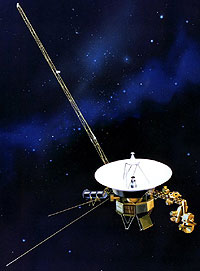 Artist concept of NASA's Voyager 1, now
Artist concept of NASA's Voyager 1, now
the most distant spacecraft from Earth.
Credit: NASAOne of the hardest things to explain to people is of the astronomical sizes and distances involved in our Universe. It's hard to explain because it’s hard for us--any of us--to really get our heads around the numbers, and what they really mean.
Along the road to understanding all things big and far away, I'll start small: the Earth.
Big as our world is, it's really only relative-- but relative to what? It's just shy of 8000 miles in diameter. As a volume of space, that's about 268 billion cubic miles. In other words, were Earth a giant fish-bowl (an empty sphere), we could divvy up that volume between every human on Earth today, and each of us would get a cube of space about three and a half miles on a side.
How about that walk to the Moon? Do you remember from elementary school how long it would take you to walk to the Moon--IF you could walk to the Moon? The Moon is about 240,000 miles away, and while it takes light only 1.3 seconds to cross that distance, walking at a speed of 3 miles per hour it would take you about nine years to get there. That's equivalent to walking around the Earth's equator ten times.
Next step out might be Mars. At least, NASA's talking about sending people to Mars next--after a return to our Moon in 2019 (note that in this plan, it will take us longer to get back to the Moon that it would to walk there...). Walking the distance to Mars, even when it's at its closest (35 million miles) would take well over a thousand years--so the walking tour is out. At NASA-speed, it takes about 7 months to get a spacecraft to Mars.
